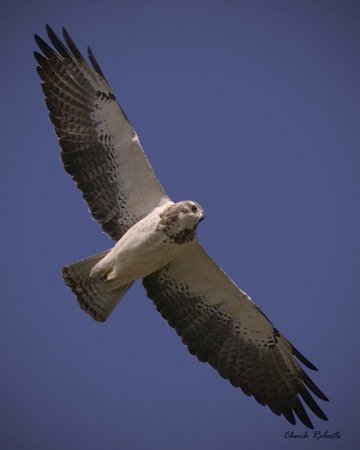Swainson's Hawk

Buteo swainsoni, SWHA
Size and Shape
L: 19” WS: 51” One of the largest common hawks, with long slender and pointed wings. Like all buteos, they have fairly broad wings and short, broad, rounded tails, though swainsons’ wings are more slender than other buteos. Like the NOHA, they hold their wings in a strong dihedral (V shape) when soaring. Has a falconlike shape when perched.
Colour Pattern
Has different color morphs (unrelated to sex): light, rufous, and dark.
Light: clean, whitish underside, with neat dark, reddish-brown chest. Wing tips and edge are black, fading in to grey. Inner wing is light like underside. Tail edge has black stripe, with rest gray–similar to wings, but neater. Plumage of 2nd year is similar to juvenile (less white underside). Wing tops all medium-brown. White stripe on top base of tail.
Dark: same outer wing as light, slightly darker. Inner wing is brown, and underside is very dark brown. Has light undertail coverts. Inner tail stripes are more noticeable, tail similar to light, but darker. Outer wing tops brownish grey, inners brown. No/little white stripe on back base of tail. Juveniles lighter, and have white stripe on top base of tail.
East of rockies (i.e. Saskatchewan), most are light morphs.
Behaviour
Swainson’s hawks are social, often found in groups, except in the breeding season. During breeding season, they feed on the usual buteo “3 R’s”, rodents, rabbits and reptiles. Outside of breeding season, they mostly eat insects. They fly in groups “kettles” that can have many, many birds, including other kinds of large birds. They are very protective of their nests.
They have adapted pretty well to finding prey in agricultural fields, though they would normally hunt in wide open grasslands/shrubland. They sometimes go after prey on foot, though they usually soar around scanning and catching food. They sometimes perch on irrigation rigs and then go after the rodents who get soaked out.
During the winter, they migrate pretty far down into south america, past Brazil. They are often in their largest groups when travelling like this.
Call
kieeeaar, slightly higher pitched than red-tailed.
Habitat
Like wide open space, and nest in trees (often the only tree available). They may prefer higher nests, though they seem to have a high adaptability to whatever large vegetation is available.
http://macaulaylibrary.org/search?taxon=swainsons%20hawk&taxon_rank_id=67&taxon_id=11994990&tab=video-thumb